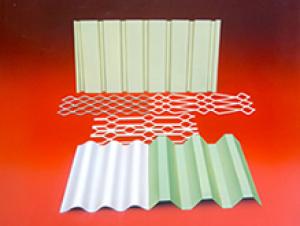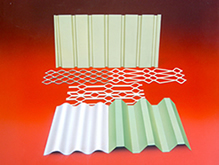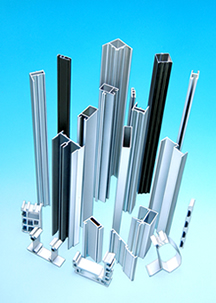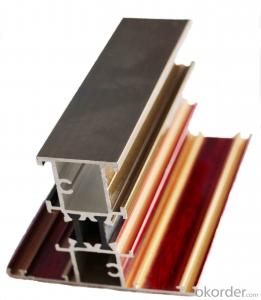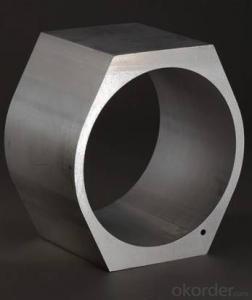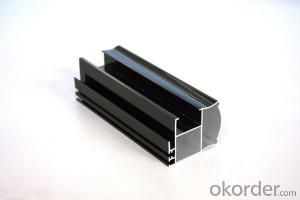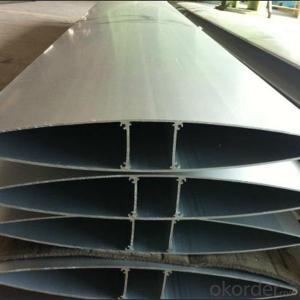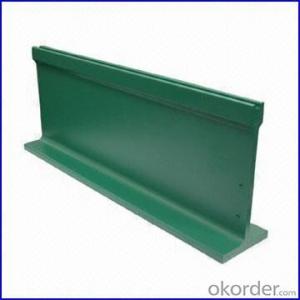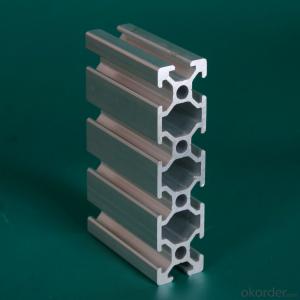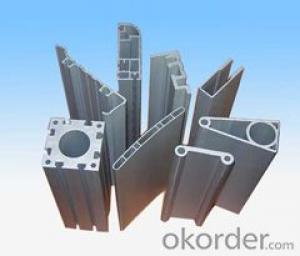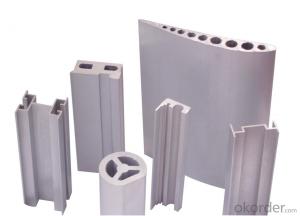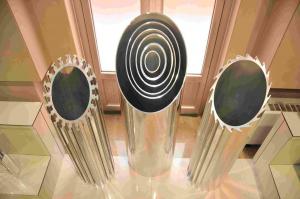Round Aluminum Extrusion Profiles for Aviation and Aerospace
- Loading Port:
- China Main Port
- Payment Terms:
- TT OR LC
- Min Order Qty:
- -
- Supply Capability:
- -
OKorder Service Pledge
OKorder Financial Service
You Might Also Like
Due to fine corrosion resistance, sufficient strength, excellent process performance and welding property, aluminum alloys are widespread applied in the fields of building’s structure, windows & doors, ceilings, decoration faces etc. the SWA’s aluminum products for architecture & decoration are primarily comprised of color coated sheet and bare sheet for coating, curtain wall sheet, as well as 7 series of ordinary window & door profiles, 3 series of profiles for heat-insulated window & door, 5 series of profiles for visible-frame curtain wall, 7 series of profiles for hidden-frame curtain wall.
SWA’s architectural & decorative aluminum products are entitled as “Satisfactory Product” by the Client Committee of China Consumer Association.
It was the “Recommended Products” designated by the China Architectural Decoration and Fitting Association.
SWA’s bare sheet for coating (2002), color coated sheet (1998, 2001, 2004), architectural profiles (2003) have been commented as the “Famous Brand Product of Chongqing”.
SWA’s color coated aluminum sheets and curtain wall Al sheets, that were developed and put into market in batches in early 1990s, have filled a vacancy domestically.
- Q: Are aluminum profiles suitable for bathroom fittings and accessories?
- Yes, aluminum profiles are suitable for bathroom fittings and accessories. Aluminum is a corrosion-resistant material that can withstand moisture and humidity in a bathroom environment. Additionally, aluminum profiles offer versatility in design, durability, and are lightweight, making them an ideal choice for bathroom fittings and accessories.
- Q: Can aluminum profiles be used for curtain wall systems?
- Yes, aluminum profiles can be used for curtain wall systems. In fact, aluminum is one of the most commonly used materials for curtain wall construction due to its numerous advantages. Aluminum profiles offer excellent strength and durability, making them capable of supporting the weight of large glass panels. Additionally, aluminum is highly resistant to corrosion, which is essential for exterior applications where the curtain wall is exposed to various weather conditions. Moreover, aluminum profiles can be easily extruded into various shapes and sizes, allowing for design flexibility and customization. The lightweight nature of aluminum also makes it easier to handle and install, reducing labor and transportation costs. Furthermore, aluminum is a sustainable material as it is recyclable, contributing to the overall sustainability of the curtain wall system. Overall, aluminum profiles are a suitable choice for curtain wall systems due to their strength, durability, corrosion resistance, design flexibility, and sustainability.
- Q: How to sell and sell industrial aluminium profiles?
- For the industrial aluminum profile enterprise, this is the most valuable customer resource, and also is the high-quality customer we usually call. Of course, the quality of customer mining, the most important thing is to discuss and communicate with customers. We must start from the position of customers, understand their requirements for products, know what they want to achieve the desired, can use their brains, for them to benefit by mutual discussion, analysis and reflection, so customers are thinking, anxious customers, so in fact, let customers choose our is the logical thing. It should be said that this is the most critical moment in the whole sale, so don't let yourself lose here.
- Q: This question asks for an overview of the various types of aluminum profiles that are typically utilized in construction projects.
- <p>Aluminum profiles used in construction come in various types, each serving specific purposes. Common types include: 1. Extruded Profiles: These are the most common, created by forcing aluminum through a die to achieve desired shapes. 2. Structural Profiles: Used for structural integrity in buildings, such as beams and columns. 3. Fa莽ade Profiles: Specifically designed for the exterior cladding of buildings. 4. Window and Door Profiles: For frame construction in windows and doors. 5. Fastening Profiles: Used for joining and fixing other aluminum components. 6. Special Profiles: Custom-made for unique applications. 7. Decorative Profiles: For aesthetic purposes, enhancing the appearance of structures. Each type has specific properties and is chosen based on the structural requirements and design considerations of the construction project.</p>
- Q: What are the possible alternatives to aluminum extrusions in the construction industry?
- <p>Yes, there are several alternative materials that can replace aluminum extrusions in construction projects. These include steel, which is strong and durable but heavier; fiberglass, known for its lightweight and corrosion resistance; and thermoplastics like PVC, which are cost-effective and easy to work with. Each material has its own advantages and limitations, and the choice depends on the specific requirements of the project, such as strength, weight, cost, and environmental factors.</p>
- Q: How does the aluminum profile bevel come round?
- If the stitching aluminum alloy model is the same, then the cutting angle must be 45 degrees, it is possible to splice.You can try it yourself and make a small tool to fix this angle in advance.
- Q: What are the potential hazards or risks associated with the use of aluminum profiles in construction projects?
- <p>Safety concerns related to using aluminum profiles in construction include potential corrosion due to exposure to harsh weather conditions, risk of electrical conductivity which may lead to electrocution hazards, and the possibility of thermal expansion and contraction causing structural instability. Additionally, improper installation can lead to structural failure, and the lightweight nature of aluminum may not provide sufficient strength in load-bearing applications. It's crucial to ensure proper design, quality materials, and adherence to safety standards to mitigate these risks.</p>
- Q: What unique considerations or specifications are needed when utilizing aluminum profiles in cold weather conditions?
- <p>In cold climates, special requirements for using aluminum profiles include selecting materials with enhanced thermal performance to prevent condensation and frost. It's crucial to use aluminum profiles with appropriate thermal breaks to reduce heat loss. Additionally, consider using profiles with higher strength to withstand the contraction and expansion caused by temperature fluctuations. Protective coatings or finishes may be necessary to prevent corrosion from salt or other winter chemicals. Always consult with manufacturers for specific recommendations tailored to the climate conditions.</p>
- Q: Can aluminum profiles be painted or coated?
- Yes, aluminum profiles can be painted or coated.
- Q: What are the load-bearing capacities of aluminum profiles?
- The load-bearing capacities of aluminum profiles vary depending on several factors such as the profile design, dimensions, material grade, and the intended application. Aluminum profiles are commonly used in a wide range of industries due to their excellent strength-to-weight ratio. However, it is crucial to consult the manufacturer or engineer for specific load-bearing capacity information. Aluminum profiles are typically engineered to withstand different types of loads, including static, dynamic, and impact loads. Static loads refer to the weight or force that remains constant over a period of time, while dynamic loads involve moving or changing forces. Impact loads, on the other hand, are sudden forces that occur due to collisions or sudden changes in motion. To determine the load-bearing capacity of an aluminum profile, engineers consider the maximum allowable deflection, bending moment, shear force, and torsional stress that the profile can withstand without failing. These calculations involve analyzing the geometry, cross-sectional properties, and material properties of the profile. It is important to note that load-bearing capacities can also be affected by various factors such as temperature, corrosion, surface treatment, and the presence of any additional components or attachments. Therefore, it is essential to consider these factors and consult the manufacturer's specifications or engineering guidelines to ensure safe and reliable load-bearing capabilities. In summary, the load-bearing capacities of aluminum profiles are influenced by multiple factors and can vary significantly. It is advisable to consult with manufacturers, engineers, or industry standards to determine the specific load-bearing capacity for a particular aluminum profile in a given application.
Send your message to us
Round Aluminum Extrusion Profiles for Aviation and Aerospace
- Loading Port:
- China Main Port
- Payment Terms:
- TT OR LC
- Min Order Qty:
- -
- Supply Capability:
- -
OKorder Service Pledge
OKorder Financial Service
Similar products
Hot products
Hot Searches
Related keywords
